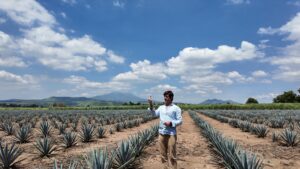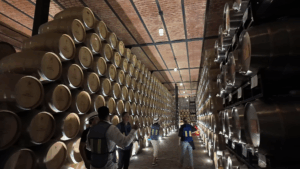Behind the Scenes at the Volcan de Mi Tierra Distillery, a Larger-Than-Life Gamble on the Future of Tequila

(Photos: LVMH)
In hindsight, it’s surprising that French luxury conglomerate LVMH, the powerhouse behind Hennessy, Moët & Chandon and Krug Champagne, didn’t get into the tequila game until 2017. When the day finally came, much was happening in the world of agave spirits. The tequila boom had finally descended in full effect upon the United States, sending descriptors like “additive-free” and “tahona-crushed” straight into the zeitgeist. Consumers were learning about the difference between highland and lowland agaves, and early cult interest in brands like Fortaleza paved the way for the industry’s first undeniable unicorn bottlings.
The possibilities were limitless — and Volcan de Mi Tierra capitalized on every last drop. Founded in partnership with the Gallardo family, Volcan is a dedicated distillery (one of frightfully few) that’s gone to great lengths to marry traditional techniques with modern technology. The resulting spirit is rich in flavor, history and, particularly when it comes to its production process, labyrinthine complexity.
On a recent trip to tequila country, we were guided through the facility by CEO Santiago Cortina Gallardo and CCO Carlos Pechieu, both of whom were remarkably candid about the inner workings of their passion project.
From Volcano to Bottle

CCO Carlos Pechieu standing in a field of Blue Weber agave next to the distillery. In the background, the famous Volcán de Tequila. In his hand, a piece of stray obsidian dug up from the dirt.
Volcan de Mi Tierra derives its name from the eponymous Volcán de Tequila — quite literally, the Tequila Volcano. No, the edifice doesn’t shoot out spurts of searing hot agave spirits (though that sounds like it’d make for an excellent, albeit dangerous gag gift). Instead, the many-millennium-old dormant volcano gave its title to the nearby town of Santiago de Tequila, founded in 1530 as a refuge for Cazcan indigenous peoples who had lived scattered across the nearby mountains. Years later, the town gave birth to a spirit then known as vino de mezcal de tequila and… for the sake of time, let’s just say the rest is history.
Many connections between mountain and bottle persist to this day. It’s the iron-rich, volcanic soil of Jalisco that imbues tequila with its signature mineral profile. Look closely enough, and you can even find chunks of obsidian lodged in the dirt of many a Blue Weber agave field.
It was in one of those fields that our journey began. Patches of sugarcane and foliage stretched to the horizon and beyond, glimmering bright green under the beating sun. The team admitted that it was an unusual change of scenery. Over the past few months, the area has undergone one of its wettest rainy seasons in recent history — a fantastic turn of events for pretty much all agriculture except agave. Bear in mind that the Blue Weber used to make tequila only requires half a liter of water a year to survive, hence the crop’s emergent popularity in drought-struck regions like California.
We’d heard rumors of agave abandoned en masse across Mexico as irrigation ditches overflowed and killed budding plants. Though that may have been the case on some stretches of the Volcan estate, everything we saw looked like it had survived the downpour intact. The agaves extended from the ground no further than knee’s length, still years away from blooming into full-grown plants that could be harvested, roasted, fermented and distilled to perfection. Bugs fluttered aimlessly in every direction. The scratch on my shoelace: A reminder that agave branches, no matter their age, are as pointy as a freshly sharpened knife.

Construction vehicles lug piles of chopped agave onto a conveyor belt, leading to a traditional brick oven in which the hearts are slow-roasted.
Inside the facility, trimmed agave hearts are splintered into halves and thirds before being lifted in overflowing heaps by a squad of construction vehicles. One of the workers held a silver hook in hand, spiking it into the fifty-pound chunks and tossing them onto a conveyor belt.
This is where things begin to get complicated. It had been impressed upon us how “time-intensive” the Volcan process was, but frankly, the specifics didn’t sound like much more than boastful marketing claims. That first impression was sorely mistaken.
The brand uses not one but three different tequilas inside its flagship Blanco, each of which demands a different combination of agaves and machinery. The distillery cooks both highland agaves (typically sweeter, more fruit-forward) and lowland agaves (earthy, spicy and peppery) by way of brick ovens (old-school) or autoclaves (decidedly new school). After that, the roasted hearts are processed through either a roller mill, which shreds the plants with a series of small wheels, or the iconic tahona, a lumbering volcanic slab that slowly but surely crushes agaves into an aromatic, orangish pulp.
Is it convoluted? Absolutely. Though blended tequilas aren’t entirely unheard of, it’s quite uncommon for a brand to utilize the technique as its bread and butter. In the hands of Volcan, it creates a blanco that smells like the highlands and sips like the lowlands, skewing toward a bold black pepper note that stops just short of overwhelming subtle hints of tropical fruit and florality. Delicious stuff from front to end. And, in all likelihood, impossible to replicate at a facility that wasn’t specifically engineered for the task.

A pair of bulking tahona wheels are one of several tools in Volcan’s repertoire.
Very few tequila brands boast a dedicated distillery. Of the 2,300-some names currently available on the market, only around a dozen are produced at a facility responsible for that brand and that brand alone. The small handful of distillers that fall into this group — Fortaleza, El Tequileno, Alto Canto, Codigo 1530 — are held in high regard among the nerdy agave spirits crowd. It’s considered a badge of honor and testament to focus. A sharp contrast to notorious bulk distillers, some of whom are responsible for well over 100 brands under the same roof.
What’s unusual about Volcan De Mi Tierra — and I can’t overstate this enough — is the size and scale of the operation. Walking into the main chamber of the factory, guests are greeted by over a dozen copper stills lined up along the wall, facing off against a legion of 30-foot steel fermentation tanks and colossal wooden pipones. Having visited my fair share of tequila distilleries over the years, I can safely say that Volcan is one of the largest (add to that immaculately, almost unreasonably clean from floor to ceiling).
Were upper management to give the order, the grounds could easily produce a small army of brands, and chances are, they’d be pretty damn good. But that’s not how the cookie crumbles at Volcan. My impression was that the Gallardo family has a singular focus on elevating one brand (their brand) to the upper echelons of success, and preemptively built a distillery capable of any and all expansion needs. If you leave this article with just one impression, let it be that Volcan is betting big — platinum-chip, pool-of-gold, Scrooge McDuck big — on the future of tequila.

The Volcan facility has enough fermentation tanks and stills to produce an army of tequila brands. Yet, it focuses only on one.
Nowhere is that ambition more apparent than in the barrel cellar. Along one of the factory’s many walls lies a 15-foot wooden door that slides aside on soundless wheels. Behind it, an ominous tunnel stretches deep into the earth, curving ever so slightly at the end to conceal what’s buried beneath. It was a surprisingly theatrical level of mystique for a distillery not open to public tours, and our guides played it up to full effect. We descended toward the inner sanctum with phones held high.

Into the depths.
Eight feet below ground, the Volcan cellar houses row upon row of beige barrels, each de facto hallway carved out by a line of LEDs. Pechieu told us that the cellar stores around 3,500 barrels, and I would’ve believed him if he tacked on a few thousand more. Some were etched with the words “Grace Oak,” the brand’s proprietary cask type used to mature the high-end Volcan X.A. Many more reached too high toward the ceiling to read the details.
Nestled in the corner was a small stack of steel drums, each labeled with a bespoke cask finish. I spotted Sauternes, Ardberg scotch, red wine and a handful of varying ABVs distilled from tahona-crushed agave. These were future single-barrel releases each of which is available to collectors at a price tag so obscene it dare not be repeated. Our guides name dropped a few LVMH-adjacent celebrities who had sampled the juice, though it was unclear whether any had walked away with a batch of their own.

Each of Volcan’s steel single barrels is outfitted with a miniature faucet, allowing guests to sample the goodies within.
Our journey ended with a visit from Maestro Tequilero Marcelino Lucke, who poured us glasses of an unreleased Volcan bottling slated to hit the market sometime next year. We’d been offered plenty of tasty samples throughout the day, but nothing quite like this. Tasting notes: Barrel char, marmalade on toast and extra crispy creme brûlée.
If you’re interested in seeing more, be sure to check out our behind-the-scenes video at the Volcan de Mi Tierra distillery.
Follow The Daily Pour:
About The Daily Pour
Founded by Dan Abrams, The Daily Pour is the ultimate drinking guide for the modern consumer, covering spirits, non-alcoholic and hemp beverages. With its unique combination of cross-category coverage and signature rating system that aggregates reviews from trusted critics across the internet, The Daily Pour sets the standard as the leading authority in helping consumers discover, compare and enjoy the best of today's evolving drinks landscape.
